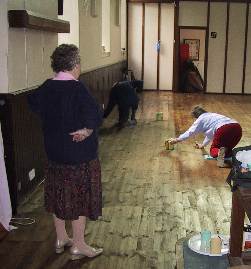 By 9th March the varnishing was about half-way
complete, with the second coat going on under the watchful eye
of our Minister, Rev. Pat Hunter. With at least one day needed
to dry between coats, we laid the final coat on 12th March, ready
for the new chairs to be delivered on 15th. As it happened, the
floor had extra time to harden as the chairs were delayed, so
we had one service on all the old chairs we could gather up,
and then on Monday 19th.... By 9th March the varnishing was about half-way
complete, with the second coat going on under the watchful eye
of our Minister, Rev. Pat Hunter. With at least one day needed
to dry between coats, we laid the final coat on 12th March, ready
for the new chairs to be delivered on 15th. As it happened, the
floor had extra time to harden as the chairs were delayed, so
we had one service on all the old chairs we could gather up,
and then on Monday 19th.... |
|
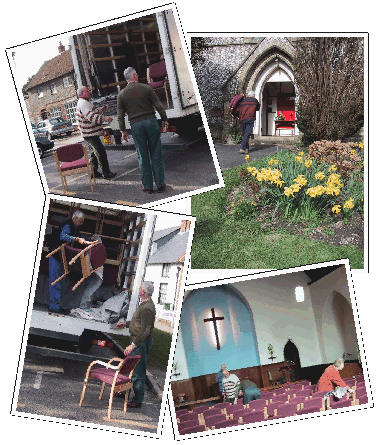 ... they arrived! The volunteers turned out to carry
them up the path from the delivery van, and to arrange them in
the Church. This took longer than we had thought, because we
had many more options, and tried out lines, arches, and even
considered how to arrange them for a service in 'the round'.
We also tried to allow room for a bridal procession, and tried
to pre-empt any 'access' requirements to allow for emergency
evacuation. Our estimates were not far off, but we probably have
a few more chairs than we can comfortably fit in at one go. This
is the right side to be, though, to allow for those days when
we have a full Church. (Yes, they do happen!) ... they arrived! The volunteers turned out to carry
them up the path from the delivery van, and to arrange them in
the Church. This took longer than we had thought, because we
had many more options, and tried out lines, arches, and even
considered how to arrange them for a service in 'the round'.
We also tried to allow room for a bridal procession, and tried
to pre-empt any 'access' requirements to allow for emergency
evacuation. Our estimates were not far off, but we probably have
a few more chairs than we can comfortably fit in at one go. This
is the right side to be, though, to allow for those days when
we have a full Church. (Yes, they do happen!)
The final milestone was a special service
of re-dedication on Sunday 15th April, at which we hid a 'time
capsule' under the floor. We hope it will be discovered by a
whole new generation of Steyning Methodists many years in the
future. |
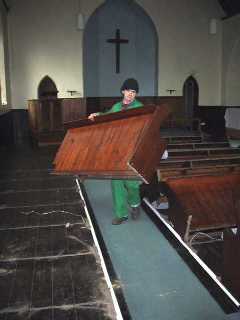
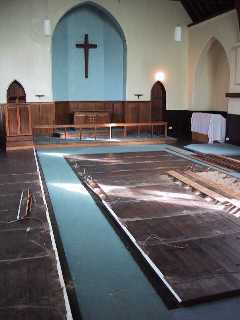
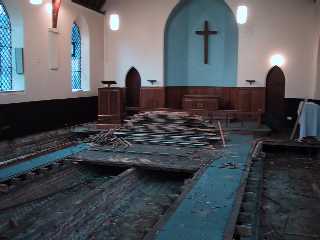
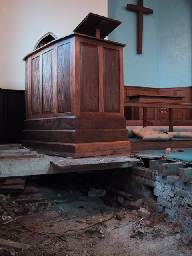 The area under the pulpit has needed special
attention, because the joists supporting the raised floor also
support the pulpit. Once the floor was lifted it became apparent
that these joists had to be replaced as well, so the pulpit was
moved out of the way.
The area under the pulpit has needed special
attention, because the joists supporting the raised floor also
support the pulpit. Once the floor was lifted it became apparent
that these joists had to be replaced as well, so the pulpit was
moved out of the way.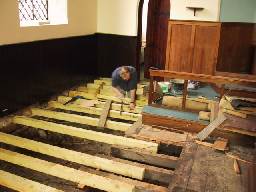
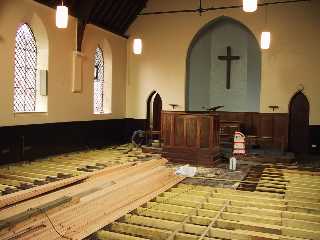 The new floor joists were in position and
levelled by 15 February. The new floorboards can be seen in the
pile in the centre of the Church, with the pulpit moved to one
side on what remains of the old floor.
The new floor joists were in position and
levelled by 15 February. The new floorboards can be seen in the
pile in the centre of the Church, with the pulpit moved to one
side on what remains of the old floor.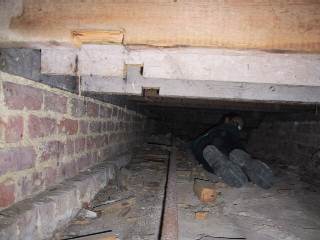
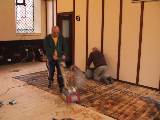 By 5th March the floor was complete and ready
for varnishing. First we had to sand the old surface off the
parts of the original floor in order to match the colour of the
new. We hired an industrial sander to do this and expected to
be able to complete it within a day, but one section of carpet
had been glued to the floor, and the sander couldn't cope with
this - it simply melted the glue and moved it around! The only
way to remove it was to dissolve it with white spirit and scrape
it off. Once this was done, and the surface removed, the whole
floor was given one final sanding along the grain to remove the
scuff marks and to prepare it for staining.
By 5th March the floor was complete and ready
for varnishing. First we had to sand the old surface off the
parts of the original floor in order to match the colour of the
new. We hired an industrial sander to do this and expected to
be able to complete it within a day, but one section of carpet
had been glued to the floor, and the sander couldn't cope with
this - it simply melted the glue and moved it around! The only
way to remove it was to dissolve it with white spirit and scrape
it off. Once this was done, and the surface removed, the whole
floor was given one final sanding along the grain to remove the
scuff marks and to prepare it for staining.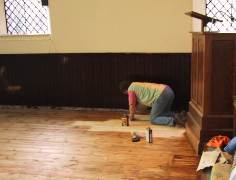 We opted to stain the floor with wood dye
first rather than use the more modern woodstain. The drawback
was having to apply it by rubbing it in with a rag rather than
painting it on, which took three people most of the day. We worked
in parallel from the back wall forwards, and it was a great relief
when we finally reached the pulpit and the end was in sight.
The advantage was that we could leave it to dry and still go
back to correct any patches where the stain was uneven. This
proved to be necessary the following day, as some areas were
more heavily stained than others, and the boundaries between
some areas were noticeable. After a touch-up with diluted dye
we were ready to varnish.
We opted to stain the floor with wood dye
first rather than use the more modern woodstain. The drawback
was having to apply it by rubbing it in with a rag rather than
painting it on, which took three people most of the day. We worked
in parallel from the back wall forwards, and it was a great relief
when we finally reached the pulpit and the end was in sight.
The advantage was that we could leave it to dry and still go
back to correct any patches where the stain was uneven. This
proved to be necessary the following day, as some areas were
more heavily stained than others, and the boundaries between
some areas were noticeable. After a touch-up with diluted dye
we were ready to varnish. By 9th March the varnishing was about half-way
complete, with the second coat going on under the watchful eye
of our Minister, Rev. Pat Hunter. With at least one day needed
to dry between coats, we laid the final coat on 12th March, ready
for the new chairs to be delivered on 15th. As it happened, the
floor had extra time to harden as the chairs were delayed, so
we had one service on all the old chairs we could gather up,
and then on Monday 19th....
By 9th March the varnishing was about half-way
complete, with the second coat going on under the watchful eye
of our Minister, Rev. Pat Hunter. With at least one day needed
to dry between coats, we laid the final coat on 12th March, ready
for the new chairs to be delivered on 15th. As it happened, the
floor had extra time to harden as the chairs were delayed, so
we had one service on all the old chairs we could gather up,
and then on Monday 19th.... ... they arrived! The volunteers turned out to carry
them up the path from the delivery van, and to arrange them in
the Church. This took longer than we had thought, because we
had many more options, and tried out lines, arches, and even
considered how to arrange them for a service in 'the round'.
We also tried to allow room for a bridal procession, and tried
to pre-empt any 'access' requirements to allow for emergency
evacuation. Our estimates were not far off, but we probably have
a few more chairs than we can comfortably fit in at one go. This
is the right side to be, though, to allow for those days when
we have a full Church. (Yes, they do happen!)
... they arrived! The volunteers turned out to carry
them up the path from the delivery van, and to arrange them in
the Church. This took longer than we had thought, because we
had many more options, and tried out lines, arches, and even
considered how to arrange them for a service in 'the round'.
We also tried to allow room for a bridal procession, and tried
to pre-empt any 'access' requirements to allow for emergency
evacuation. Our estimates were not far off, but we probably have
a few more chairs than we can comfortably fit in at one go. This
is the right side to be, though, to allow for those days when
we have a full Church. (Yes, they do happen!)